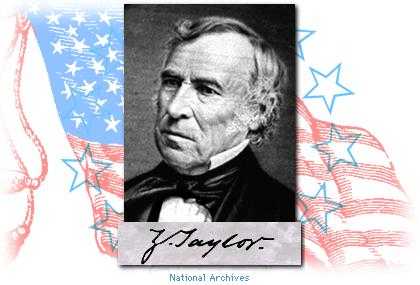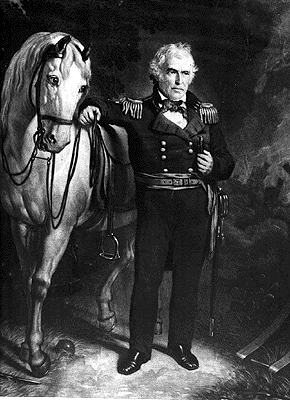
Zachary Taylor was US President # 12

For the second time in the history of the Republic, March 4 fell on a Sunday.
The inaugural ceremony was postponed until the following Monday, raising the question as to whether the Nation was without a President for a day.
Zachary Taylor had refused to pay postage due on a letter to him, and in the letter it told him that he had won the presidency. So he would have known sooner if only he paid the postman.
General Taylor never had voted in a national election until his own contest for the Presidency.
Outgoing President Polk accompanied the general to the ceremony at the Capitol.
The oath of office was administered by Chief Justice Roger Taney on the East Portico.
Taylor was sworn in as president on March 5, 1849.
A huge crowd swarmed to Washington, D.C., to witness the inauguration. Many of them were office seekers hoping to be appointed to an office under the first Whig administration since 1841.
Taylor had at first intended to be a nonpartisan president, but under pressure from his advisers he adopted the spoils system, awarding offices to party loyalists.
As a result, much of his time and many of his problems concerned the demands of unemployed Whig politicians.
His administration was marked, however, by his personal honesty and courage, especially in the handling of the delicate question of slavery.
Taylor thought of himself as an independent. He always had disliked the Democratic Party's stand on the money issue. He favored a strong and sound banking system and thought that Andrew Jackson had foolishly destroyed the Second Bank of the United States. Jackson's use of party politics to award patronage seemed dishonest and corrupt to Taylor.
And while he owned slaves, he thought it impractical to talk about expanding slavery into western lands where neither cotton nor sugar could easily be grown in a plantation economy.
Although Taylor did not like the Whigs' stand on protective tariffs or expensive internal improvements, he aligned himself with Whig governing principles.
He believed that the president should not and could not use the veto unless a law was unconstitutional. Taylor also felt that the president should not interfere with Congress. A strong cabinet and collective decision-making were also important to him. These were all Whig principles.
Most importantly, Taylor was a strong nationalist. Because he had seen too many of his comrades die in battle, he did not look favorably upon secession as a solution to national problems.
He also carried a personal grudge against President Polk. Taylor blamed Polk for allowing General Scott to cut his forces in half at Buena Vista—a plot to set-up Taylor for defeat and thus, sidetrack his growing popularity with the public.

Taylor thought the presidency should stand above party politics, and he appointed cabinet members who represented all sections and the "great interests" of the nation. None of them were prominent Washington politicians. Additionally, Taylor refused to have anything personally to do with patronage, delegating the job of firing Democrats and appointing Whigs to key positions on his cabinet. He gave great authority to his cabinet, using it like a council of war. He refused to develop a close working relationship with Congress.
Cabinet:

Did You Know and Notable Events about this President ~>
1850 The Clayton-Bulwer Treaty signed with Britain guaranteed that any future canal across Central America would be available to all nations.
*
First President who had not served in Congress or the Continental Congress.
First President to be elected from a state west of the Mississippi.
When Taylor moved into the White House he brought his mount Whitey with him.
Margaret Taylor hired an artist to draw this picture of her dying husband. And this may also be the only picture of her available, even though it does not show her face. And their daughter is there also

Taylor was 64 years old when he assumed the presidency. Years of service on the frontier had taken their toll of his health, and he came close to death when he fell ill during a trip through Pennsylvania in September 1849. The duties of his office also wore him out. He was especially depressed when three members of his Cabinet were charged with corruption, leaving him open to vicious attacks from Congress that were all the more venomous because of his stand on slavery.
On July 4, 1850, Taylor stood in the hot sun at the foot of the Washington Monument in Washington, D.C., listening to patriotic speeches celebrating Independence Day. That night he had an attack of cholera morbus, or acute indigestion, and he died five days later. His last words were,
"I regret nothing, but I am sorry to leave my friends."

Click on the NEXT-BUTTON to see the last page ~>
NEXT-BUTTON
Click on the BACK-BUTTON to go back to the start ~>
BACK-BUTTON